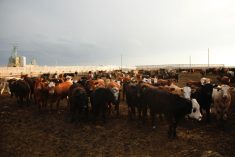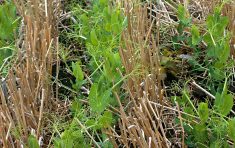MarketsFarm — Very few crops took more of a hit during the drought-stricken summer of 2021 than dry peas. Meanwhile, firm international demand and tightening stocks will raise pea prices even higher.
According to Agriculture and Agri-Food Canada’s (AAFC) latest field crop estimates released Friday, pea production dropped 45 per cent at 2.527 million tonnes for the 2021-22 marketing year, compared to the year before. With 2.3 million tonnes of peas slated for export, that’s to leave only 50,000 tonnes in ending stocks, compared to 479,000 from the year before.
The drought “didn’t do much to bolster carryout stocks, that’s for sure,” said Daryl Domitruk, executive director of Manitoba Pulse and Soybean Growers, adding that pea yields were variable across that province, up to 60 bushels per acre.
Read Also

Prairie Wheat Weekly: U.S. futures pressure Canadian prices
Pressure on U.S. futures and variable weather conditions on the Prairies brought Western Canadian wheat bids down during the week ended July 10, 2025.
Pea protein has experienced a surge in demand mainly due to greater interest in plant-based protein alternatives like meat substitutes. Most of Manitoba’s peas, according to Domitruk, are purchased by Roquette, whose pea processing plant near Portage la Prairie, billed as the largest of its kind, is expected to reach full capacity next year.
The protein market “looks like it’s real and it’s growing. That is creating demand and lucky for us, it’s creating local demand,” said Domitruk. “But that’s really a small part of the overall demand for peas, which is driven by the export market. It really depends on what buyers like China require and where they’re going to be in the marketplace.
“We saw prices come up a little bit and we saw companies looking for peas in the eastern Prairie market. For producers who haven’t contracted all of their peas and had some available, they were able to take advantage of some delivery opportunities and some higher prices. But that was only a certain number of producers who were lucky enough to have a decent crop.”
Despite the drought and the ensuing yields, Domitruk maintained that peas are a dry weather crop and can rebound next year. Local and export demand for the crop, as well as rising prices for nitrogen (for which peas have little need) also may make the crop more desirable for producers.
“That combination of export demand and local demand is buoyant, but it does require significant export demand to be there, which impacts local prices for domestic consumption,” he said.
— Adam Peleshaty reports for MarketsFarm from Stonewall, Man.
For more content related to drought management visit The Dry Times, where you can find a collection of stories from our family of publications as well as links to external resources to support your decisions through these difficult times.





















